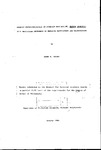HEPATIC MICROSPORIDIOSIS OF JUVENILE GREY MULLET, CHELON LABROSUS, WITH PARTICULAR REFERENCE TO PARASITE DEVELOPMENT AND TRANSMISSION
| dc.contributor.author | RALPHS, JAMES R. | |
| dc.contributor.other | School of Biological and Marine Sciences | en_US |
| dc.date.accessioned | 2013-10-28T12:40:58Z | |
| dc.date.available | 2013-10-28T12:40:58Z | |
| dc.date.issued | 1984 | |
| dc.identifier | NOT AVAILABLE | en_US |
| dc.identifier.uri | http://hdl.handle.net/10026.1/2417 | |
| dc.description.abstract |
Microgemma hepaticus gen.n.sp.n. is described from the liver of juvenile mullet, Chelon labrosus. Development occurs within xenomas, of diameter 500 µm. These have microvillar surfaces, encircling bands of mitochondria and a reticulate nucleus with many nucleoli. Meronts are plasmodial, divide by plasmotomy and are enclosed within host membranes. Sporonts are free in the cytoplasm and divide by multiple exogenous budding. In sporogenesis the polar sac is formed from golgi vesicles, the manubrium form a dense golgi body and the coiled polar filament form a spiral cisterna linked with the perinuclear membrane system and golgi reticulum. This was also implicated in the formation of the endospore. The polaroplast developed from expanded sacs derived from the manubrium. Uninucleate spores (4.2 x 2.4 µm) possessed 7-9 filament coils and lamellar polaroplast. Foci of infection were associated with liver connective tissue, and histopathological effects limited to adjacent cell necrosis due to pressure atrophy in restricted sites. Host responses result in granuloma formation, with gradual resolution of the lesion. In vitro investigations into spore hatching and viability showed exsporulation was stimulated by oxidising agents and following pretreatment with media of low pH or high osmolarity. Inoculation of spores into RTG cell cultures resulted in observations of a freshly injected sporoplasm, and a plasmodial stage after 72 hours. The ultrastructure of extruded filaments, spore cases and cell penetration is described. Attempts at transmission of the parasite to mullet by stomach tube, feeding of crustacean spore carriers or intraperitoneal injection were unsuccessful and suggested that larval fishes may be the targets of infection. The possible transmission of the parasite in the marine environment is discussed. On the basis of structural and developmental features the genus Microgemma is placed in the family Unikaryonidae. The affiliation of the genus with other fish microsporidia is noted, and wider implications of life cycles and nuclear behaviour to taxonomy and evolution are discussed. | en_US |
| dc.language.iso | en | en_US |
| dc.publisher | University of Plymouth | en_US |
| dc.title | HEPATIC MICROSPORIDIOSIS OF JUVENILE GREY MULLET, CHELON LABROSUS, WITH PARTICULAR REFERENCE TO PARASITE DEVELOPMENT AND TRANSMISSION | en_US |
| dc.type | Thesis | |
| dc.identifier.doi | http://dx.doi.org/10.24382/3255 | |
| dc.identifier.doi | http://dx.doi.org/10.24382/3255 |
Files in this item
This item appears in the following Collection(s)
-
01 Research Theses Main Collection
Research Theses Main


